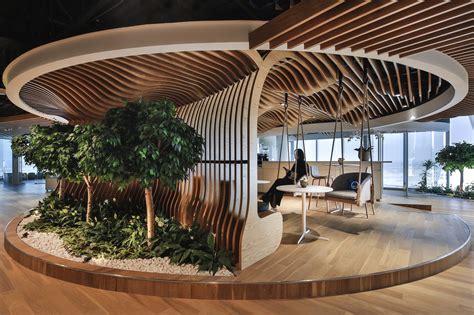In today’s fast-paced and consumer-driven world, the emphasis on creating sustainable and eco-friendly spaces has never been more critical. As an interior designer, your role in promoting environmental consciousness and sustainability is more important than ever. In this blog post, we will explore the various aspects of creating sustainable spaces and how interior designers can play a pivotal role in this movement. From understanding the concept of sustainable spaces to identifying key elements for sustainability and incorporating eco-friendly materials and techniques, we will delve into the crucial steps that can be taken to promote sustainability in interior design. We will also discuss the role of managing energy consumption, promoting natural lighting and ventilation, designing for optimal water efficiency, and utilizing sustainable furniture and decor. Additionally, we will explore the integration of smart home technology and biophilic design principles in interiors, demonstrating how these innovative approaches can contribute to creating sustainable and environmentally-friendly spaces. Join us as we embark on this journey towards a more sustainable future in interior design.
Table of Contents
Understanding the concept of sustainable spaces
When we talk about sustainable spaces, we are referring to the design and implementation of interior spaces that are environmentally friendly, socially responsible, and economically viable. This concept goes beyond just using eco-friendly materials and reducing energy consumption; it also involves creating spaces that have a positive impact on the health and well-being of their occupants.
Sustainable spaces are designed to minimize their environmental footprint by using resources efficiently, minimizing waste, and reducing pollution. This can be achieved through the use of renewable materials, energy-efficient appliances, and water-saving fixtures. Additionally, sustainable spaces seek to create a healthy indoor environment by improving air quality, optimizing natural light and ventilation, and incorporating biophilic design principles.
Another important aspect of sustainable spaces is their social and economic impact. These spaces are designed to be inclusive and accessible to all, regardless of age, ability, or socioeconomic status. They also contribute to the local economy by supporting local businesses and artisans, and by creating jobs in the green building and design industry.
In summary, the concept of sustainable spaces encompasses not only the use of eco-friendly materials and techniques, but also the integration of social and economic responsibility into the design and management of interior spaces.
Exploring the role of an interior designer
Interior designers play a crucial role in shaping the aesthetics and functionality of an indoor space. They are responsible for creating environments that are not only visually appealing but also sustainable and practical. A professional interior designer possesses the skills and expertise to understand the client’s needs, develop design concepts, and execute plans that transform ordinary spaces into inspiring and sustainable habitats.
The role of an interior designer goes beyond just selecting color palettes and furniture. It involves a deep understanding of architectural principles, building codes, and sustainable design practices. Designers must consider the environmental impact of their choices and strive to incorporate eco-friendly materials and techniques into their designs.
Furthermore, interior designers are tasked with creating spaces that are energy efficient and promote natural lighting and ventilation. They must also be well-versed in managing energy consumption and designing spaces for optimal water efficiency. These responsibilities require a keen eye for detail and a strong commitment to sustainability.
Ultimately, the role of an interior designer is to merge creativity with practicality, while also prioritizing sustainability and the well-being of the occupants. By embracing these principles, interior designers can make significant contributions to creating healthy, eco-friendly, and aesthetically pleasing environments for people to live and work in.
Identifying key elements for sustainability
When it comes to creating sustainable spaces, it is important to identify the key elements that contribute to sustainability. These key elements are essential for ensuring that the design and construction of a space are environmentally friendly and promote long-term sustainability.
One of the key elements for sustainability is the use of renewable materials. Incorporating materials such as bamboo, cork, or reclaimed wood can significantly reduce the environmental impact of a space. These materials are not only sustainable, but also add a unique and natural aesthetic to the interior design.
Another important element for sustainability is energy efficiency. Designing spaces with energy-efficient appliances, lighting, and HVAC systems can significantly reduce energy consumption and lower utility costs. Additionally, promoting natural lighting and ventilation can further enhance energy efficiency in interior design.
Furthermore, water efficiency is a crucial element for sustainable spaces. Implementing low-flow fixtures, greywater systems, and water-efficient landscaping can help conserve water resources and minimize water waste in interior design.
Incorporating eco-friendly materials and techniques
When it comes to interior design, one of the key elements for sustainability is the incorporation of eco-friendly materials and techniques. These days, there is a growing emphasis on the use of sustainable and environmentally friendly materials in the construction and design industry. Designers are now opting for materials that have a low carbon footprint and are sourced from renewable and recyclable sources.
One popular eco-friendly material that is being widely used in interior design is reclaimed wood. Reclaimed wood not only adds a rustic and natural element to a space, but it also helps in reducing the demand for new timber, thus contributing to forest conservation. Another technique that is gaining traction is the use of low VOC (volatile organic compound) paints and finishes, which are much safer for both human health and the environment compared to traditional paints.
Furthermore, there is a growing trend of using recycled and upcycled materials in interior design. Items such as recycled glass countertops, repurposed furniture, and salvaged metal fixtures are being incorporated into designs to reduce waste and promote sustainability. Designers are also exploring innovative techniques such as 3D printing using eco-friendly materials, creating unique and sustainable design elements.
Overall, the incorporation of eco-friendly materials and techniques in interior design not only helps in creating healthier and more sustainable living spaces, but also contributes to the greater environmental cause of reducing our carbon footprint and preserving natural resources for future generations.
Managing energy consumption in interior design
As an interior designer, managing energy consumption should be a top priority when creating sustainable spaces. Utilizing energy-efficient appliances and lighting can significantly reduce the carbon footprint of a building. Additionally, incorporating smart home technology, such as programmable thermostats and light sensors, can help regulate energy usage and optimize efficiency.
Another key aspect of managing energy consumption in interior design is the use of renewable energy sources. Integrating solar panels or wind turbines into the design can provide clean, sustainable energy to power the building. Additionally, considering the orientation and layout of the space to maximize natural light can reduce the reliance on artificial lighting and decrease energy consumption.
Furthermore, managing energy consumption also involves the selection of materials and finishes that contribute to thermal comfort. Proper insulation, energy-efficient windows, and strategic placement of shading devices can all contribute to reducing the need for excessive heating and cooling, ultimately saving energy.
In conclusion, managing energy consumption in interior design is crucial for creating sustainable and environmentally friendly spaces. By implementing energy-efficient appliances, utilizing renewable energy sources, and optimizing natural light and ventilation, interior designers can significantly reduce the carbon footprint of a building and promote a more sustainable future.
Promoting natural lighting and ventilation
When it comes to creating sustainable spaces, one of the key elements to consider is the promotion of natural lighting and ventilation. These two factors not only contribute to the overall well-being of the occupants but also play a significant role in reducing the energy consumption of a space.
By strategically positioning windows, skylights, and other openings in a building, interior designers can maximize the natural light entering the space. This not only reduces the need for artificial lighting during the day but also creates a more inviting and pleasant environment for occupants.
In addition to natural lighting, promoting proper ventilation is also crucial for sustainable interior design. Good ventilation helps maintain indoor air quality, reduces the reliance on mechanical HVAC systems, and promotes a healthier living or working environment.
Overall, incorporating strategies to promote natural lighting and ventilation in interior design not only enhances the aesthetic appeal of a space but also contributes to its overall sustainability and the well-being of its occupants.
Designing spaces for optimal water efficiency
When it comes to interior design, sustainability should always be a top priority. One of the key elements of sustainable design is water efficiency. Designing spaces for optimal water efficiency not only helps conserve water but also contributes to creating a greener and more eco-friendly environment.
It is important to incorporate water-efficient fixtures such as faucets, showers, and toilets that are designed to reduce water usage without compromising functionality. Low-flow fixtures and dual-flush toilets are great options for minimizing water waste in interior spaces.
Another essential aspect of designing for water efficiency is utilizing sustainable landscaping techniques. This includes designing outdoor spaces with native plants that require less water, implementing efficient irrigation systems, and utilizing rainwater harvesting techniques to reduce the reliance on traditional water sources.
Additionally, incorporating water-saving technologies such as smart irrigation systems and water-efficient appliances can significantly contribute to reducing water consumption in interior design projects. These advancements not only help conserve water but also contribute to lowering utility costs for homeowners and building occupants.
Utilizing sustainable furniture and decor
Utilizing sustainable furniture and decor is an essential aspect of promoting environmental consciousness in interior design. By choosing materials and products that are environmentally friendly, interior designers can contribute to a more sustainable and eco-friendly living environment.
One key element in utilizing sustainable furniture and decor is the use of reclaimed or repurposed materials. These materials not only add a unique and artistic touch to interior spaces but also reduce the demand for new resources and minimize waste.
Another important factor to consider is the durability and longevity of furniture and decor. Investing in high-quality pieces that are built to last not only reduces the need for frequent replacement but also minimizes the environmental impact of manufacturing and disposal.
Furthermore, choosing locally sourced and fair trade furniture and decor supports local artisans and communities while reducing the carbon footprint associated with transportation and production.
Implementing smart home technology for sustainability
In today’s rapidly changing world, the focus on sustainable living has become more important than ever. As technology continues to advance, the integration of smart home technology has emerged as a key component in achieving sustainability in interior design.
By incorporating smart home technology into interior spaces, individuals can actively monitor and control energy usage, ultimately reducing their impact on the environment. From smart thermostats that regulate heating and cooling based on occupancy, to smart lighting systems that adjust brightness and color temperature, these technologies enable homeowners to optimize energy efficiency and minimize waste.
Furthermore, the use of smart home technology can extend beyond energy conservation to promoting a more eco-friendly lifestyle. Automated systems for water management, such as smart irrigation controllers and leak detection sensors, contribute to optimal water efficiency within the home, while reducing the overall environmental impact.
As the demand for sustainability continues to grow, the implementation of smart home technology has the potential to revolutionize the way we design and inhabit interior spaces, ultimately leading to a more eco-conscious and environmentally responsible future.
Integrating biophilic design principles in interiors
Integrating biophilic design principles in interiors involves incorporating natural elements and patterns into the built environment to create a connection between humans and nature. This design approach aims to enhance the well-being and productivity of occupants while promoting environmental sustainability.
One key element of biophilic design is the use of natural materials such as wood, stone, and plants to bring the outdoors inside. These elements can help create a sense of calm and reduce stress, ultimately improving the overall quality of the indoor space.
Additionally, the strategic placement of windows and skylights can maximize natural lighting and ventilation, allowing for a seamless connection to the outdoor environment. This not only reduces the need for artificial lighting and air conditioning, but also creates a more comfortable and inviting atmosphere for occupants.
Furthermore, incorporating biophilic design principles can lead to greater energy efficiency and water conservation in interior spaces, ultimately contributing to a more sustainable built environment. By leveraging the innate human connection to nature, biophilic design can transform interiors into rejuvenating and eco-friendly spaces that benefit both occupants and the planet.






